RBA Annual Conference – 2018 Monetary and Macroprudential Policies: The Case for a Separation of Powers Ben Broadbent[*]
- Download 1.1MB
Periodically, public services in Britain are criticised for what is described as a ‘target culture’. The charge is that, because they're asked by politicians to concentrate on the more prominent and observable objectives of the job, public services can pay too little attention to their less visible requirements, even when those are equally important. If you ask doctors to prioritise a reduction in waiting lists, they might then spend too little time with individual patients. If schools are judged only by exam results, there's a risk that they ‘teach to the test’ and neglect the broader aspects of education.
What these jobs have in common is that they involve multiple objectives, some of which are more easily measured than others. Many jobs are like this and economists have suggested that this can explain why, in the real world, performance-based pay contracts are much less prevalent than one would expect. In general, and certainly if someone's performance can be easily verified, it helps to offer incentives of this sort (Fernie and Metcalf 1999; Groves et al 1994). But if oversimplified targets sufficiently distort an employee's incentives, because they ignore the less verifiable aspects of a job, it can be better simply to pay a flat wage.[1]
The same analysis can also be used to think about how multiple tasks should be allocated in the first place. In some cases the various aspects of a job are inextricably linked – they can only be done by one person. Those broader parts of a child's education have to be provided by the same institution – a school – that teaches what's needed to pass exams. But in other cases, the allocation may be a matter of choice. When it is, it turns out that it makes sense – all else equal – to group the more visible objectives together, in one job, and the less verifiable tasks in another. This limits the risk that one dominates the other.
I think this insight has some bearing on how central banks, whose responsibilities have been expanded since the global financial crisis (GFC), should be organised. Specifically, it's relevant when deciding whether the newly created ‘macroprudential’ policies should be conducted separately or jointly with monetary policy.
Some have argued that, because there are significant interactions between the two, monetary and macroprudential policy should be housed not just in the same institution, but in the same policymaking committee within the central bank. The distinct Monetary Policy Committee (MPC) and Financial Policy Committee (FPC) should become a single ‘FMPC’.
My purpose today is to put the case for continued separation, albeit within the single Bank of England (BoE). I think the interactions between the two policies are often overstated, particularly in small open economies like the United Kingdom. Domestic interest rates have a smaller effect on financial stability, and financial policy a less significant impact on demand and inflation, than sometimes suggested. And whatever the benefits of formal coordination, a full merger could compromise accountability. The risk is that a single committee would pay too much attention to its more verifiable objectives – the cyclical stabilisation of inflation and growth, currently allocated in the main to the monetary policymaker – and too little to financial stability.
I should say before I start that nothing I say here is very novel. Others, including my predecessor Charlie Bean and the economist Lars Svensson, have made similar points about the interaction of monetary and macroprudential policy (Bean et al 2010; Svensson 2015). I discovered when writing this paper that my former colleague Paul Tucker made very similar arguments regarding accountability back in 2011 (Tucker 2011). FPC external member Donald Kohn (2017) gave a talk on this topic only a few months ago. There is, more generally, a substantial and growing literature on the governance of macroprudential policy and its interaction with monetary policy.
But the case for a merger is still being made – one still hears the argument that the two policymaking committees should be collapsed into one – and, if the arguments against are worthwhile, they probably bear the odd repetition.
Here, at any rate, is the plan for this paper: I'll begin with a very brief account of the development of macroprudential policy frameworks since the GFC; I'll then explain why I think interaction with monetary policy, and therefore the gains from formal coordination of the two, are often overstated, particularly in more open economies with floating exchange rates. (One relevant observation here is that some countries had a much worse experience than others during the GFC – the United Kingdom versus Australia is an example – despite having somewhat lower inflation. This suggests that, at least in open economies, financial stability depends much more on prudential policy than on monetary policy.) Hoping you'll forgive the clumsy word, I'll then make some remarks about the difference in the ‘measurability’ of the performance of the two policies. There's a short concluding section at the end.
1. Macroprudential Policy, Monetary Policy and the Limited Costs of Separation
The GFC prompted a radical overhaul of financial regulation. Much of this involved the rules for individual institutions, most obviously minimum levels of capital for banks. In the United Kingdom, banks' equity is now around 5 per cent of their unweighted assets, around 14½ per cent on a risk-weighted basis. These ratios are many times what they were prior to the GFC (Figure 1).
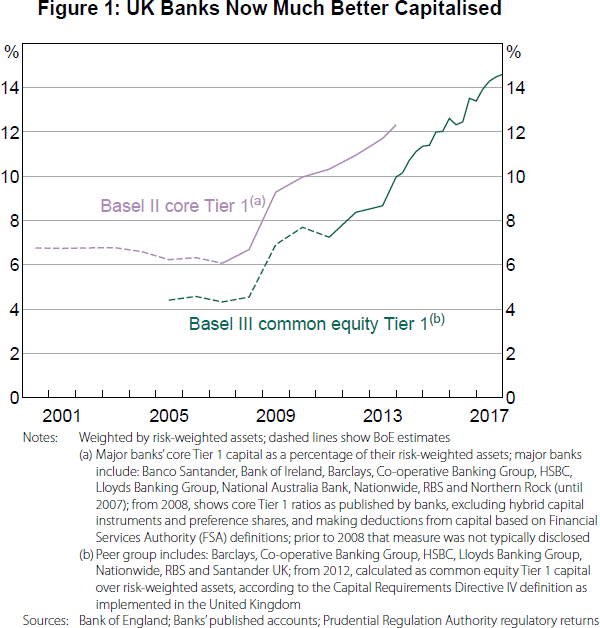
Recognising the feedback mechanisms that so amplified the severity of the GFC, there were also reforms designed to ensure the stability of the financial system as a whole. Extra capital is now required for institutions judged to be systemically important. Trading in many derivatives has been shifted to central clearing houses, and the associated collateral requirements tightened. And in several countries, new authorities have been created to identify and mitigate system-wide risks, using what is known as macroprudential policy. In the United Kingdom, macroprudential policy is conducted by the FPC, housed within the BoE. Mirroring the set-up for the BoE's MPC, the FPC's remit is set by the UK Government but it is operationally independent of the executive and accountable directly to parliament.
There are many instruments that might fall under the heading of macroprudential policy, some of which – quantitative restrictions on lending, for example – have, in one form or another, been around for a long time (Elliott, Feldberg and Lehnert 2013; Goodhart 2015). Others, such as the countercyclical capital buffer, are newer. But a distinctive feature of the policy is that it should be responsive to economic and financial conditions. The primary aim is to ensure that the financial system should be sufficiently robust that it doesn't act to amplify economic cycles by increasing the supply of credit in good times and curtailing it in bad times. And, if it's to react in this way, macroprudential policy needs to be flexible over time.
This raises the question of its interaction with monetary policy. In moderating financial risks, macroprudential policy could, in principle, affect activity and inflation, for which the MPC is held responsible. Conversely, if changes in interest rates affect asset prices and credit markets, they may have an impact on financial stability. And, if both policies affect both objectives, how should they then be used? Is it right that official interest rates should be set only with inflation in mind, leaving financial stability to prudential policy alone – or should the burden be shared in some way, in which case decisions might better be set by a single committee or somehow coordinated across the two?
1.1 When policy coordination matters
There are many examples of these issues in the economics literature. While the details are often case specific, there are basically two sets of conditions that tend to favour coordination.
One is that there are material cross-policy spillovers: A's actions have to have a significant effect on B's objectives (or vice versa). Without these, it makes no difference whether two policies are set jointly or separately.
The other is that the objectives themselves are at odds with each other, or at least sufficiently distinct – and that there are economic events or shocks that can drive a wedge between them. This can create ‘push-me pull-you’ conflicts in which the two policies appear at odds with each other.[2],[3]
In some well-known instances in the economics literature, these policy conflicts are built in from the start. One involves so-called ‘currency wars’. Suppose the world as a whole is in an economic downturn and that the domestic channels of monetary policy are somehow impaired. In that case, an easing in policy works mainly by depressing the domestic exchange rate. This necessarily means stronger exchange rates, and weaker output, in other countries. A more cooperative approach, in which countries with surpluses instead eased fiscal policy and allowed their exchange rates to appreciate, would lead to better outcomes all round. But that's hard to achieve when countries act individually, because they don't take into account the effect of their actions on others.[4]
I don't see that, in either respect – whether it's the frequency of conflicting shocks or the extent of cross-policy spillovers – the situation is as serious for the monetary/macroprudential interaction.
Regarding the first, my guess is that outright conflicts between the two sets of objectives are unlikely to occur that frequently. Indeed, I suspect that, given the sorts of shocks that tend to hit the economy, the two policies will more often be complementary. Conventional aggregate demand shocks would tend to push inflation and credit growth in the same direction. The same goes for independent shocks to the supply of domestic credit: expansions in lending are more likely to occur alongside periods of relatively strong economic growth and rising inflationary pressure than are economic downturns. In that case, and to the extent there really are cross-policy spillovers, the two policies will tend to help rather than hinder each other.
1.2 The UK experience
Broadly speaking, I think this is exactly what's happened over the past few years. In the United Kingdom one sometimes hears that the historically low interest rates after the GFC have been fuelling ‘unsustainable booms’ in asset prices and in lending. If that's been true at all over the past couple of decades, it's a much more accurate description of the pre-GFC economy, when interest rates were significantly higher, than of the years since.
Currently, house prices, equity prices and mortgage lending are all still materially lower, when measured in real terms, than they were a decade ago (Figure 2). In fact, this has been the first ten-year period since the Second World War in which the real stock of mortgage lending has declined in the United Kingdom. So, if there had been a macroprudential authority throughout the past twenty years, its policies would presumably have been a lot tighter in the period before the GFC than after (Meeks 2017). And the same is true of the actual level of UK Bank Rate. Unsurprisingly, given the importance of movements in credit supply in driving the economy, first up and then down, the two instruments would've moved in the same direction.
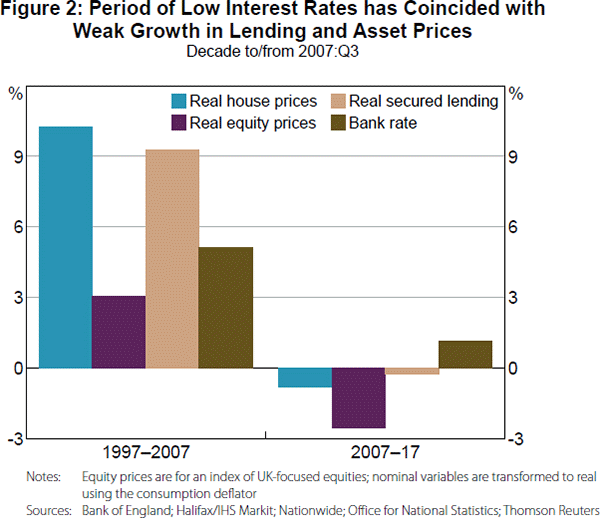
That's not to say there was no tension at all between the two objectives before the GFC. Several commentators have claimed that the financial excesses of the time could have been curbed had domestic interest rates been that much higher. Indeed, the case is still being made, even now that macroprudential tools are available, that interest rates should respond to changes in financial conditions more aggressively than their implications for inflation would warrant.
But going back to the pre-2008 period, how effective would that have been, and at what price in terms of the stability of growth and inflation?
I'm not convinced, in an open economy like the United Kindom where the financial climate is determined more abroad than at home, that higher interest rates would have helped that much – not, at least, without a materially negative impact on growth and a rate of inflation even further below the MPC's target (Figure 3).
The tendency for financial cycles to move in common across countries is apparent in data well before 2008 (Rey 2013; Baskaya et al 2017). The GFC itself was certainly global in nature, and what happened to UK banks certainly bears this out. The significant majority of the expansion in the balance sheets of UK banks ahead of the GFC, and of their losses thereafter, involved overseas assets (Figures 4 and 5). Domestic lending, the most sensitive to domestic interest rates, was not the main source of the problem.
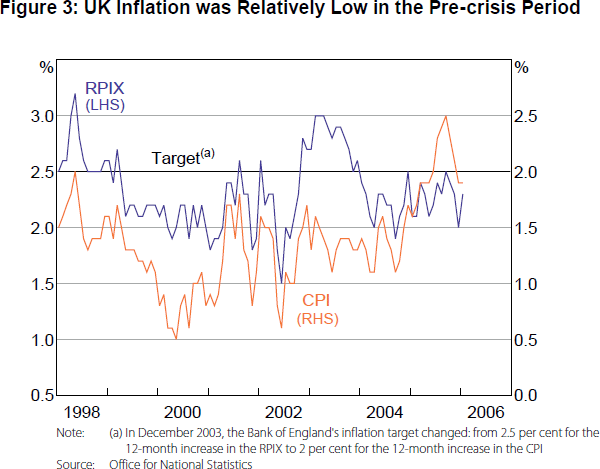
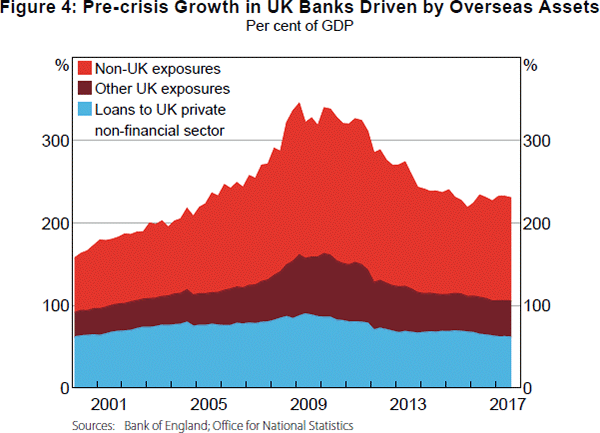
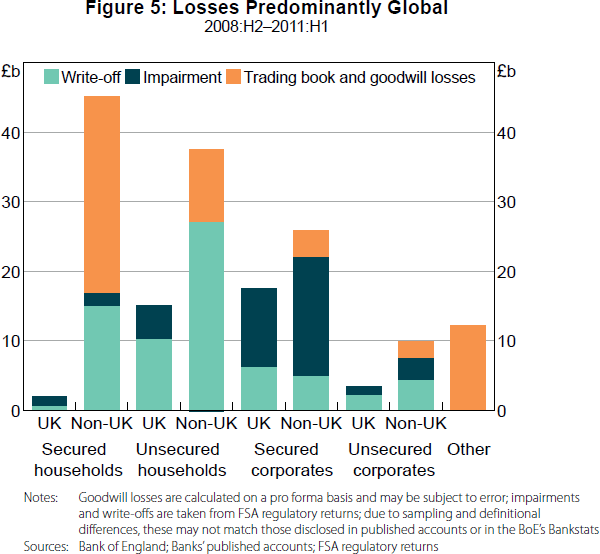
No financial crisis is exactly like another – it is now a cliché to compare them to Tolstoy's unhappy families – and I'm certainly not suggesting that domestic lending is unimportant or that the risks involved are entirely immune from domestic interest rates. But I do think that the effect is less marked the more financially open an economy is, and that the spillover effect of monetary policy – its impact on financial stability relative to that on inflation – may not be that large. If so, you'd have to pay quite a high price, in terms of output and inflation, for interest rates to be of any material help in containing independent swings in financial risks.
More careful studies bear this out. In 2010, my predecessor Charlie Bean estimated that, even had UK Bank Rate been 100 basis points higher from 2005, this would've reduced banks' balance sheets by only 3 per cent by 2008. The cost would have been 3½ per cent in foregone output and a rate of inflation more than a percentage point further below target.
In a more recent study, Aikman et al (2018) come to similar conclusions. They find not only that monetary policy has relatively weak effects on financial stability, at least in the United Kingdom, but also the converse – that, partly because they're directed more at mitigating tail risks rather than affecting the most likely path of the economy, macroprudential policies do not have very large effects on demand and inflation. Figure 6 is a summary of their results when comparing the effects of changes in policy rates and changes in the countercyclical capital buffer (CCyB). The impacts of the two policies on growth and inflation are on the left-hand side, with the effects on measures of financial stability on the right. It's very clear in this paper, at least, that the comparative advantage of monetary policy is in stabilising growth and inflation with financial stability best left to macroprudential policy.[5]
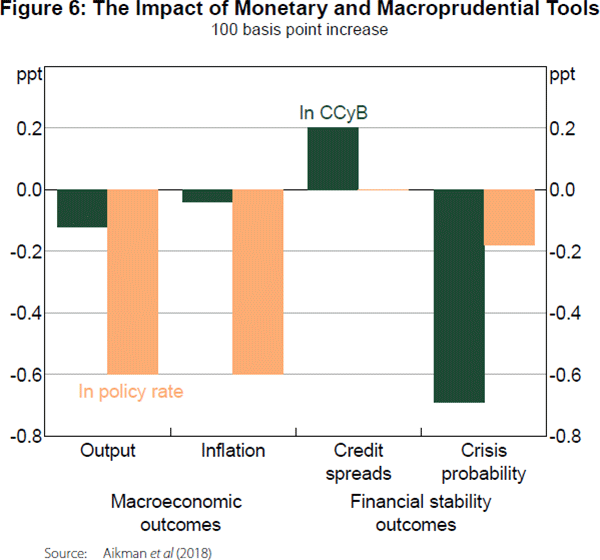
So, rather than increasing the burden on monetary policy and depressing inflation still further, what, to my mind, would have helped far more ahead of the GFC was an effective prudential policy – in particular, higher capital requirements for banks. And if that's more obvious after the event than before, let me offer one other pre-GFC comparison, this one between the United Kingdom and two countries whose experiences of the GFC were far less severe than ours, namely Canada and Australia.
These countries had significantly smaller and less international banking systems than the United Kingdom's. But policy – and specifically prudential policy – probably mattered too. Even as a share of what turned out to be much less risky assets, Canadian and Australian banks had more loss-absorbing capital (Figure 7), enough to avoid any risk of insolvency. Meanwhile, real short-term interest rates were generally lower than those in the United Kingdom (Figure 8). So monetary policy was if anything looser yet, thanks in part to better prudential policy, the GFC was far less severe.
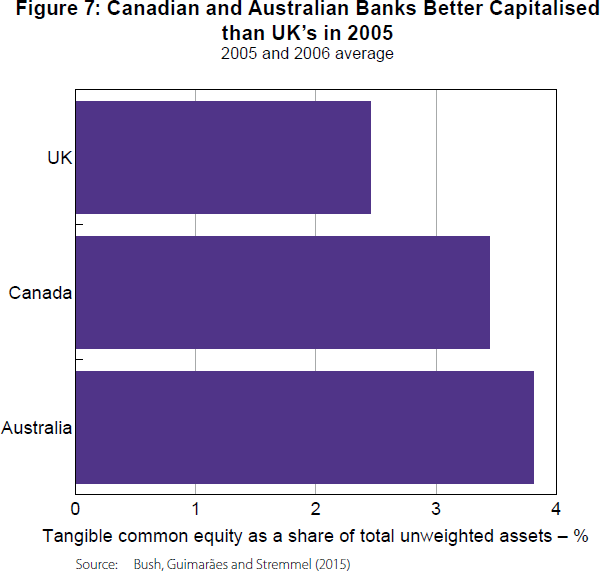
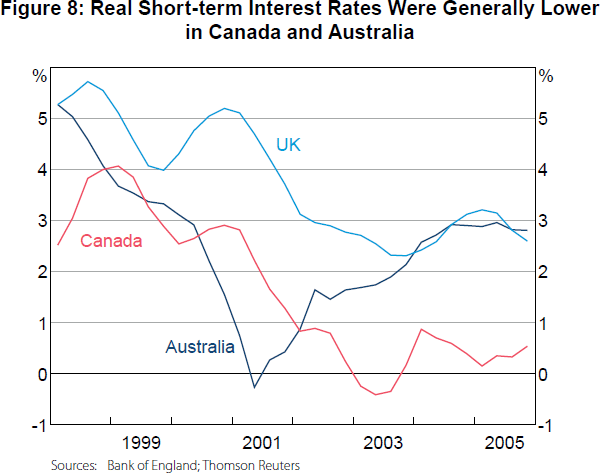
2. Some Simple Mitigants
If this is right, the gains from formal coordination might not be that significant. Even a single, ‘joined-up’ committee would generally find itself reaching for macroprudential tools to control financial risk and using interest rates to moderate cyclical swings in demand and inflation.
Shortly, in the next section, I'll offer a more positive reason to keep some distance between the two policies. Before that, I should point out that, even in instances where there may be gains from policy coordination, there are things you can do within the existing framework.
One involves the appropriate choice of secondary objectives. As I've tried to explain, the case for cooperation is stronger the more severe and frequent any conflicts between the respective objectives are. There's a very general result that puts the same point the other way around: if you give the two committees exactly the same objectives there is no coordination problem. The outcomes are the same whether their policies are set separately or jointly.
To many of you that might seem obvious (less immediately to me, I must confess). And if there's any reason at all to keep the two functions apart, it would rather defeat the purpose simply to give them the same, overarching remit. If the MPC and FPC were both made responsible for inflation control, stabilising demand and financial stability, that's a merger by default.
But the result does provide some intuition as to why you can get closer to the full coordination outcome – and in some cases replicate it exactly – by a judicious mapping of the overall objectives across the two committees. If, for example, you thought that some macroprudential measures had important spillover effects on aggregate demand, then you can get closer to the cooperative outcome simply by supplementing the remit of the macroprudential authority with the equivalent secondary objective. You ask the FPC to think not just about financial stability but also to take into account the effects of its policies on economic activity. The spillovers are then internalised and, under some circumstances, you can mimic precisely the full coordination regime. As I say, I do not believe these effects are, in fact, that powerful or, therefore, that the secondary objective will come into play very often. But it's worth pointing out that the FPC's remit was expanded in exactly this way when the Committee was put on formal statutory footing in 2012.
I think the set-up in the UK, with both committees living in the same central bank, also allows for more formal coordination in the extreme cases when the need is clear. I've explained that the gains are larger the greater the scale of cross-policy spillovers. This is a relative point: what matters is whether A's policy has a significant impact on B's objectives compared with B's own policy. In Figure 6, it's the fact that the orange bars are much bigger than the dark green on the left-hand side, and conversely on the right, that weakens the case for coordination. But, conceivably at least, there could be instances when this isn't the case – most obviously if B comes to doubt the effectiveness of its main policy instrument. Suppose, for example, that inflation is much too low but the monetary policymaker believes the zero lower bound on nominal interest rates has reduced the room for further easing. Or maybe the macroprudential authority is concerned that, in the midst of a boom, the financial system might be finding ways round its conventional tools, something that only higher interest rates could address. In these cases there would be clear gains from a more cooperative approach, in which the burden is more evenly shared.
If only conditionally, this is exactly what was proposed in the MPC's guidance about interest rates back in 2013. The MPC set out a necessary condition for UK Bank Rate to rise: that unemployment fall below 7 per cent. It also added various ‘knock-outs’ that, if breached, would automatically bring the guidance to an end. One of those involved financial stability: the guidance would become obsolete if, among other things, the FPC judged ‘that the stance of monetary policy poses a significant threat to financial stability that cannot be contained by the substantial range of mitigating [macroprudential] policy actions available …’ (Bank of England 2013, p 7).
So there has already been an episode where one policy committee accepted the possibility, however remote, that it might be asked to take into account the other's objective. I can see no reason why, if the circumstances warrant it, this shouldn't happen again.
3. The Positive Case for Separation
All I've done so far is to make the case that the separation of monetary and macroprudential policies has limited costs on average and that, if and when those costs are ever material, there are other ways, short of full integration, to deal with those situations.
Whether or not my arguments are persuasive, that doesn't mean there's no conceivable cost. In the coordination literature, in its various guises, there's always some price to pay for a separation of powers: it's inevitable, given the way things are modelled, that the ‘first-best’ answer is that policy tools should be set jointly, taking into account all the collective objectives at once. The only question is how large the costs of decentralised decision-making are and what might be done to mitigate them.
In fact, the more one reads of this stuff, the more puzzling it becomes that policies aren't more often coordinated. Economics is a positive as well as a normative science. Much of it seeks to explain why things are as they are. And if there's only upside to policy coordination, why isn't there much more of it? Why, indeed, isn't there just one, all-powerful decision-maker in charge of everything?
In the case of international coordination, perhaps the answer is obvious: only countries are wholly sovereign. That hasn't prevented all sorts of other mechanisms for joint decision-making, whether in trade, defence or environmental policy, to name a few. But, in some areas, there are limits to the extent to which national sovereignty can be compromised and, as the current debates in the euro area illustrate, fiscal policy may be one of them.
When it comes to decisions about fiscal and monetary policy, we know there's a positive reason for separation. It's harder for governments to commit to a fixed nominal objective. Because the gains from commitment are significant, it makes sense to delegate monetary policy to an independent body. (Though it happened later than in many other countries, I would argue strongly that its separation from the government – first via the introduction of inflation targeting in 1992 and then thanks to the creation of an operationally independent MPC in 1997 – has led to much improved monetary policy in the United Kingdom.)
I also think there's an additional justification for separation in many of these cases, and for monetary and macroprudential policies in particular. It's essentially a matter of accountability.[6]
I think there's little doubt that, over any limited period of time, monetary stability is more easily measured than financial stability. The MPC's primary target is inflation, as measured by the rate of change of the Consumer Prices Index (CPI). We get to see the CPI every month, it's never revised, and it's therefore reasonably clear over time whether the target has been reached.
Judging the MPC's performance is, in reality, a little more complex than this. Policy takes time to work, so it's inevitable that intervening shocks will prevent inflation from being exactly at the 2 per cent target all the time, even if that were the sole objective of policy. In addition, the MPC's remit involves a secondary objective, subject to the primary inflation target, to stabilise the real economy. If they occur, the MPC is asked to identify trade-offs between the two. However, when that has happened – for example, following the sharp fall in sterling that accompanied the result of the UK's European Union membership referendum – I don't think it's been insuperably difficult to explain the policy approach. People can then monitor how the economy is performing, relative to our earlier projections. We on the MPC, for our part, can use surveys and market prices to gauge very regularly, in ‘real time’, what's happening to inflation expectations. Judging the performance of monetary policy isn't an exact science, but we can, over time, distinguish what works from what doesn't.
Things are rather different for macroprudential policy. Financial stability is harder to define – there's no monthly ‘financial stability index’. And, while we know all too well what financial instability looks like and what its costs can be, it's more difficult to demonstrate a reduction in that risk, simply because serious problems in the financial system aren't that common to begin with.
One can make the point, albeit with an absurdly extreme example, by imagining that the only thing a sceptical outside observer can see is whether or not there has actually been such a problem. We're interested in how long it would take, possessing only this information, to conclude that the likelihood of such an event had changed.
The precise answer depends on what one means by ‘conclude’ and how sure the observer is of her prior belief.[7] But imagine, for illustration, that after a relatively long period with several such episodes, our observer's best guess is that the per annum chances of a serious problem in the financial system are 8 per cent – she expects it to happen only once every 12½ years, on average (I'm thinking of something less severe and less infrequent than the ‘once-in-acentury’ financial crisis of 2008).
What she doesn't know is that, thanks to some beneficial piece of prudential legislation, the likelihood has actually fallen to 4 per cent a year. Figure 9 shows how her estimate of the probability is likely to evolve over time. Because these events are rare, this happens only very slowly. Even if she's not that sure of her initial 8 per cent estimate – the diffuse prior line illustrates the case where the standard deviation around her prior is 2 percentage points – it's still likely to take more than 100 years for the observer's central estimate to fall even half way to the truth (i.e. to 6 per cent). If the observer's wrong but confident (the more certain prior line illustrates the case with a 1 percentage point standard deviation around the initial 8 per cent prior), one would expect it to take well over half a millennium to get to 6 per cent. King John and the barons might have tightened prudential regulation in the Magna Carta and her acknowledgement of its benefits would even now be somewhat grudging.
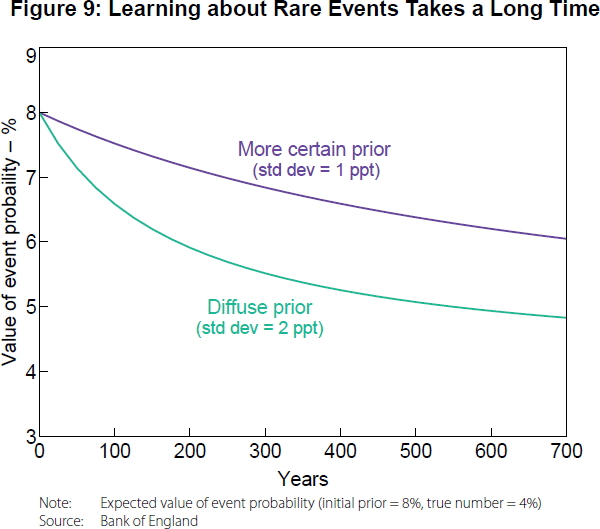
This is, as I say, a wholly unrealistic experiment because we get to see far more than the simple occurrence (or non-occurrence) of a financial crisis. Our sceptical observer would presumably be aware of the prudential legislation and, more importantly, its effects on things that relate to financial risk (e.g. asset valuations and banks' capital ratios). That information would allow a much faster updating of estimated risk than in Figure 9. In the real world, the information set available to the FPC, and by which its performance can be judged, is richer still. Having seen several such events, in many countries, we know quite a bit about what typically precedes them. Stress-testing gives us an extremely useful and powerful way to expand our knowledge about the impacts of ‘tail events’. Armed with the whole array of price and quantity indicators of risk, we – and others – can make informed judgements about the right level of loss-absorbing capital in the banking system and about the appropriateness of more targeted policy tools.
And if it takes time to demonstrate decisively a reduction in system-wide risk, there are some policies whose effects are more immediately obvious. In 2014, responding to concerns about growth in riskier mortgages, the FPC introduced limits on the share of banks' mortgage lending at high (> 4.5) loan-to-income ratios. Recently, the FPC noted that there's since been quite a bit of ‘bunching’ in new loans just below this limit. I'm not so sure this is a problem: for my part, I see it mainly as clear and timely evidence that the policy has had an impact.
The point remains, however, that the FPC's objective is inevitably less precise, and its success less immediately measurable, than that of the MPC. Recalling the results of the analysis I discussed at the start of the paper on the appropriate allocation of tasks, this suggests that there might well be a cost if you asked a single body – an ‘FMPC’ – to meet all these objectives at once. Yes, there could occasionally be instances when policies would be better coordinated (although these are rarer and less grievous than many suppose). But there's also a risk that a single committee might be incentivised to pay more attention to the more verifiable elements of its remit – the cyclical stability of growth and inflation – than to the less obvious achievement of financial stability.
4. Conclusion
In public debate, politicians often extol the virtues of ‘joined-up’ policymaking. Policies set by one body might affect another's objectives and people should be aware of such interactions. In some instances, where the interactions are sufficiently strong, it can be desirable to merge the two bodies into one.
But if you try pushing that argument to its logical limit – to ensure we internalise all possible spillovers let's just have one body determining every aspect of public policy – I think we'd all have misgivings with the outcome. Apart from anything else, the policymaking process would be far too complicated to hold any one bit of it to account and the all-powerful policymaker would naturally tend to focus on the more verifiable tasks. A bit like the man who loses his keys in the park but looks for them under the streetlamp ‘because that's where the light is’, the attention of policy would be directed to the most observable objectives. Perhaps we collectively fell foul of this trap, in some ways, ahead of the GFC. The risk of a rare event is not an easy thing to judge and, having gone so long without a serious problem in the financial system, our attention was distracted by the more easily monitored task of stabilising the economic cycle. Maybe people were too beguiled by the ‘Great Stability’, if only because data confirming it arrived with such regularity, to notice what was going on within the financial system.
One obvious lesson has been that the stability of inflation is no guarantee of financial stability – hence the (re-)creation of macroprudential policymaking. I think another lesson is that it's better to grant these powers to a single, accountable body, ring-fenced from the other functions of the central bank.
I don't want to overstate the case and I'm certainly not suggesting any sort of ‘Chinese wall’ between the two functions. There are clear advantages in having them housed in the same institution. Many economic issues are relevant for both and, in the BoE, the MPC and FPC regularly receive joint briefings on such matters. Even if the two hands act separately, it is important that the one should know what the other is doing and, in that respect, it helps that some people sit on both committees. And if and when there were a serious coordination challenge – for example, if one body became concerned about its ability to meet its primary objective, without enlisting the assistance of the other – then I think the current system in the United Kingdom would allow that to happen.
Equally, there are also clear advantages in a degree of separation. One – something I haven't gone into today but which still matters a great deal – concerns specialised skills. The two committees at the BoE profit greatly from having external members steeped in particular experience, whether that's monetary experts on the MPC or financial experts on the FPC. Another, the topic of this talk, is a matter of accountability and focus. I think there would be risks in asking the central bank to meet a wide range of objectives with no distinctive accounting for the use of its various tools.
Thank you.
Footnotes
I have benefited from helpful comments from my colleagues at the Bank of England. I would particularly like to thank Mette E Nielsen, Richard Harrison, Lien Laureys, Roland Meeks, Ambrogio Cesa-Bianchi and Matthew Corder for their valuable research assistance. The views expressed are my own and do not necessarily reflect those of the Bank of England or other members of the Monetary Policy Committee. [*]
The key reference in the economics literature is Holmstrom and Milgrom (1991). [1]
The economists Howard Davies and Sushil Wadhwani have both made arguments for a merged committee. Speaking in 2010, Wadhwani put it like this: suppose that we have a house price bubble and the FPC increases capital requirements. This slows the economy and leads the MPC to lower the policy rate. Can we be confident that this does not keep the house price boom going? (Wadhwani 2010). [2]
It's worth emphasising here that the mere fact that policies might move in opposite directions – that at any one time macroprudential policy might (say) be ‘tight’ and monetary policy ‘loose’ – doesn't in and of itself mean there's a coordination problem. Facing an economy with low inflation and rapid credit growth, a single policymaker might well choose such a policy setting. It's generally the case that, as long as there are at least as many objectives as policy instruments, and when there can be independent shocks to those objectives, the policy instruments will occasionally move contrariwise, whatever the arrangements for setting them. For example, the same would be true in an economy with a weak economy but an undesirably high public sector deficit – the right reaction, even for a single decision-maker, could well be to set tight fiscal policy but loose monetary policy (see Kohn (2017) on this point). [3]
Differences in objectives also drive many results concerning fiscal and monetary policy coordination. The literature is significant and diverse. But one strand (e.g. Sargent and Wallace 1981; Leeper 1991; Bianchi and Melosi 2018) examines the implications for monetary policy of an exogenous and unsustainable path for fiscal policy; another (e.g. Dixit and Lambertini 2003) considers the strategic interaction between the two when the monetary authority has more conservative objectives for output and inflation than the fiscal authority. There may, of course, be gains to coordination even if both authorities recognise the same social welfare function but are assigned different parts of it, particularly when commitment is not possible for either, but the most severe problems nonetheless result from explicit disagreements. [4]
See also Ferrero, Harrison and Nelson 2018. [5]
By that I do not mean we necessarily need better oversight of policy. We would all have a sense, I think, of the virtue of the separation of powers as a check on their possible abuse. ‘[I]n all the subordinate distributions of power, where the constant aim is to divide and arrange the several offices in such a manner as that each may be a check on the other’, is how James Madison (1788) put it. That's not the issue here: a second committee wasn't created so it could keep an eye on the first and there are plenty of robust mechanisms – our public communications and press conferences and, more formally, the direct accountability to (and regular interrogations by) parliament – that already hold the various parts of the central bank to public account. [6]
The observer updates her distribution over the probability using Bayes' law. Figure 9 is the mean of that updated distribution as a function of the number of years of data that the agent has observed. [7]
References
Aikman D, J Giese, S Kapadia and M McLeay (2018), ‘Targeting Financial Stability: Macroprudential or Monetary Policy?’, Bank of England Staff Working Paper 734.
Bank of England (2013), Inflation Report, August.
Baskaya YS, J di Giovanni, Ş Kalemli-Özcan, J-L Peydro and MF Ulu (2017), ‘Capital Flows and the International Credit Channel’, Journal of International Economics, 108(Supplement 1), pp S15–S22.
Bean C, M Paustian, A Penalver and T Taylor (2010), ‘Monetary Policy after the Fall’, Paper presented at the Federal Reserve Bank of Kansas City Economic Policy Symposium on ‘Macroeconomic Challenges: The Decade Ahead’, Jackson Hole, 26–28 August.
Bianchi F and L Melosi (2018), ‘Constrained Discretion and Central Bank Transparency’, The Review of Economics and Statistics, 100(1), pp 187–202.
Bush O, R Guimarães and H Stremmel (2015), ‘Beyond the Credit Gap: Quantity and Price of Risk Indicators for Macroprudential Policy’, Unpublished manuscript, Bank of England.
Dixit A and L Lambertini (2003), ‘Interactions of Commitment and Discretion in Monetary and Fiscal Policies’, The American Economic Review, 93(5), pp 1522–1542.
Elliott DJ, G Feldberg and A Lehnert (2013), ‘The History of Cyclical Macroprudential Policy in the United States’, Board of Governors of the Federal Reserve System Finance and Economics Discussion Series No 2013-29.
Fernie S and D Metcalf (1999), ‘It's Not What You Pay It's the Way that You Pay It and that's What Gets Results: Jockeys' Pay and Performance’, Labour: Review of Labour Economics and Industrial Relations, 13(2), pp 385–411.
Ferrero A, R Harrison and B Nelson (2018), ‘Concerted Efforts? Monetary Policy and Macro-Prudential Tools’, Bank of England Staff Working Paper No 727.
Goodhart CAE (2015), ‘Linkages between Macro-Prudential and Micro-Prudential Supervision’, Butterworths Journal of International Banking and Financial Law, 30(10), pp 607–609.
Groves T, Y Hong, J McMillan and B Naughton (1994), ‘Autonomy and Incentives in Chinese State Enterprises’, The Quarterly Journal of Economics, 109(1), pp 183–209.
Holmstrom B and P Milgrom (1991), ‘Multitask Principal–Agent Analyses: Incentive Contracts, Asset Ownership, and Job Design’, Journal of Law, Economics & Organization, 7(Special Issue), pp 24–52.
Kohn D (2017), ‘Cooperation and Coordination across Policy Domains’, Keynote speech given at the Financial Stability Institute Conference ‘Supervisory Policy Implementation in the Current Macro-Financial Environment – “A Cross-Sectoral Journey”’, Basel, 18–19 September.
Leeper EM (1991), ‘Equilibria under “Active” and “Passive” Monetary and Fiscal Policies’, Journal of Monetary Economics, 27(1), pp 129–147.
Madison J (1788), ‘The Structure of the Government Must Furnish the Proper Checks and Balances between the Different Departments’, Federalist Papers No 51. Available at <https://billofrightsinstitute.org/founding-documents/primary-source-documents/the-federalist-papers/federalist-papers-no-51/>.
Meeks R (2017), ‘Capital Regulation and the Macroeconomy: Empirical Evidence and Macroprudential Policy’, European Economic Review, 95, pp 125–141.
Rey H (2013), ‘Dilemma not Trilemma: The Global Financial Cycle and Monetary Policy Independence’, in Global Dimensions of Unconventional Monetary Policy, A Symposium Sponsored by the Federal Reserve Bank of Kansas City, Kansas City, pp 285–333.
Sargent TJ and N Wallace (1981), ‘Some Unpleasant Monetarist Arithmetic’, Federal Reserve Bank of Minneapolis Quarterly Review, 5(3), pp 1–17.
Svensson LEO (2015), ‘Monetary Policy and Macroprudential Policy: Different and Separate’, Paper presented at the Federal Reserve Bank of Boston's 59th Economic Conference ‘Macroprudential Monetary Policy’, Boston, 2–3 October.
Tucker P (2011), ‘Macroprudential Policy: Building Financial Stability Institutions’, Speech given at the 20th Annual Hyman P Minsky Conference ‘Financial Reform and the Real Economy’, New York, 13–15 April.
Wadhwani SB (2010), ‘What Mix of Monetary Policy and Regulation is Best for Stabilising the Economy?’, in The Future of Finance: The LSE Report, London School of Economics and Political Science, London, pp 145–163.